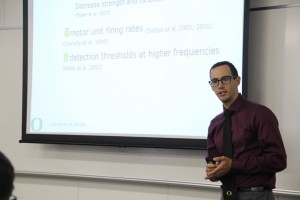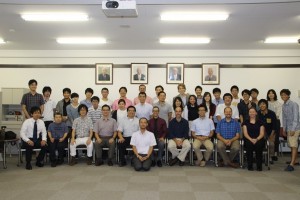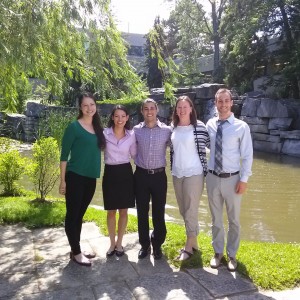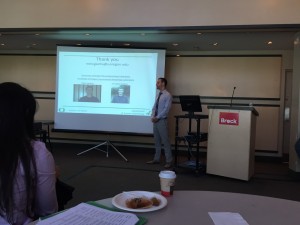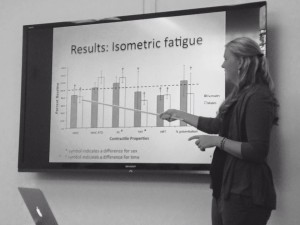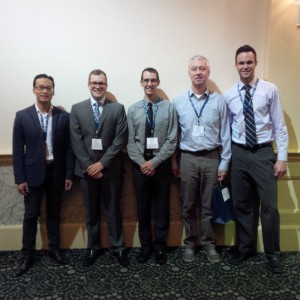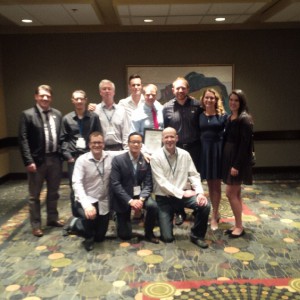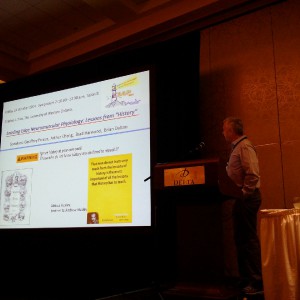Mark Bogost Thesis Defense (March 16, 2016)
Mark Bogost successfully defended his Master’s project “Three dimensional cortical activity representation of whole-body surface translations during single and dual-task paradigms”. Mark is officially Dr. Dalton’s first completed graduate student. A big thanks to his program committee, Drs. Anita Christie and Marjorie Woollacott.
2015 Tokyo University of Science – University of Oregon Biomechanics Workshop (September 1-4, 2015)
Dr. Dalton and other faculty members of the neuromechanics group in the Department of Human Physiology were invited speakers at the international workshop in Tokyo, Japan. Dr. Dalton presented on the Neuromechanical control of human movement across the lifespan.
Summer Program for Undergraduate Research (SPUR) Poster Symposium (August 7, 2015)
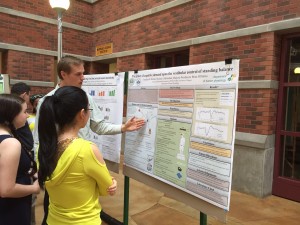 SPUR is a summer research program for undergraduates, committed to diversity and to helping make a career in scientific research more accessible to underrepresented groups. Here, Jonathan Wallace presented research he had been working on with Dr. Brian Dalton and Michael McGeehan over the summer as part of the OURS (Oregon Undergraduate Researchers in SPUR) program. The title of this poster was “The effect of cognitive demand on the vestibular control of standing balance.”
SPUR is a summer research program for undergraduates, committed to diversity and to helping make a career in scientific research more accessible to underrepresented groups. Here, Jonathan Wallace presented research he had been working on with Dr. Brian Dalton and Michael McGeehan over the summer as part of the OURS (Oregon Undergraduate Researchers in SPUR) program. The title of this poster was “The effect of cognitive demand on the vestibular control of standing balance.”
Exercise Neuroscience Group (ENG) Meeting (June 23-24, 2015)
Michael McGeehan of the Human Sensorimotor Physiology Lab with Dr. Anita Christie and associates from the Neurophysiology Lab attended the bi-annual ENG meeting held in St. Catherine’s, Ontario. During the ENG conference, 21 graduate students presented their work on subjects ranging from mental and neuromuscular fatigue to motor cortex excitability during a cognitive task.
Michael McGeehan presents his research, “Effects of increased cognitive demand on vestibular control of standing balance,” for the first time at ENG, hosted by Brock University.
Amelia Lanning Thesis Defense (May 18, 2015)
Amelia Lanning defending her Clark Honors College thesis project “SEX-RELATED DIFFERENCES OF FATIGABILITY DURING ISOTONIC CONCENTRIC CONTRACTIONS OF THE PLANTAR FLEXORS IN HUMANS.” She passed with distinction.
Human Physiology Seminar Series (December 5, 2014)
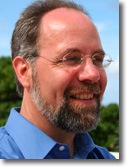 The Human Sensorimotor Physiology Lab hosted, invited speaker and world-renowned scientist, Dr. Andy Fuglevand from the University of Arizona, who is a professor of Physiology and Neuroscience in the College of Medicine. Dr. Fuglevand completed his undegraduate degree at Montana State University, his Masters degree at the University of Washington, and completed his doctoral work at the University of Waterloo with Drs. David Winter and Aftab Patla. He also received post-doctoral training with Dr. Roger Enoka (at Arizona) and Dr. Brenda Bigland-Ritchie at the John B. Pierce Laboratory. Dr. Fuglevand’s present research interests focus on understanding how the mammalian nervous system controls skeletal muscles to produce coordinated movements. For the purposes of our seminar series, Dr. Fuglevand presented an engaging talk on the “Surprising aspects of synaptic integration in motor neurons”.
The Human Sensorimotor Physiology Lab hosted, invited speaker and world-renowned scientist, Dr. Andy Fuglevand from the University of Arizona, who is a professor of Physiology and Neuroscience in the College of Medicine. Dr. Fuglevand completed his undegraduate degree at Montana State University, his Masters degree at the University of Washington, and completed his doctoral work at the University of Waterloo with Drs. David Winter and Aftab Patla. He also received post-doctoral training with Dr. Roger Enoka (at Arizona) and Dr. Brenda Bigland-Ritchie at the John B. Pierce Laboratory. Dr. Fuglevand’s present research interests focus on understanding how the mammalian nervous system controls skeletal muscles to produce coordinated movements. For the purposes of our seminar series, Dr. Fuglevand presented an engaging talk on the “Surprising aspects of synaptic integration in motor neurons”.
CSEP 2014 – St. John’s Newfoundland (October 24, 2014)
Dr. Dalton was recently apart of a scientific symposium entitled, Leading Edge Neuromuscular Physiology: Lessons from History that was a highlight of the Canadian Society of Exercise Physiology’s Annual General Meeting. This symposium brought together new investigators from several world-class laboratories to present their current ideas about neuromuscular function, which ranged from single muscle fibres to systems physiology in intact humans. Dr. Dalton concluded the symposium with a talk on “History-dependence of the vestibular-evoked postural response: The role of neck somatosensory integration.”
Invited Speakers (from left to right): Dr. Arthur Cheng; Karolinska Institute, Dr. Geoffrey Power; University of Calgary, Dr. Brian Dalton; University of Oregon; Dr. Charles Rice (Chair); University of Western Ontario, and Dr. Brad Harwood; University of Arizona.
Past and present members of the Neuromuscular Lab following the Symposium.
Charles Rice introducing the symposium.
BESbswyBESbswyBESbswyBESbswyBESbswyBESbswy
BESbswyBESbswyBESbswyBESbswyBESbswyBESbswy
BESbswyBESbswyBESbswyBESbswyBESbswyBESbswyDr. Charles Rice introducing the symposium.
